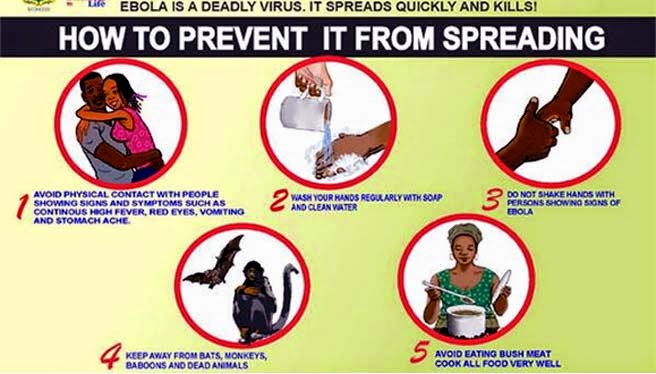Ebola Virus Disease – a zoonotic
disease
Ebola virus disease (EVD) or Ebola hemorrhagic fever (EHF)
is the human disease caused by the Ebola virus. The virus is a type of
ribonucleic acid (RNA) virus. Ebola virus hemorrhagic fever is a zoonotic
disease transmitted to human by direct contact with infected live or dead
animals, and more specifically with their body fluid. Genetic and antigenic
characterization of Ebola virus isolated during human outbreaks has led to the
identification of 5 subtypes. Ebola hemorrhagic fever is a disease caused by 5
different subtype /strains of Ebola virus, these viruses infect humans and non
human primates. Ebola viruses are mainly found in primates in Africa and
possibly the Philippines, there are only occasional outbreaks of infection in
humans.

Ebola hemorrhagic fever occurs mainly in Africa in the Republic of the
Congo, Gabon, Sudan, Ivory Coast and Uganda, but it may occur in other African
countries. Ebola virus can be spread by direct contact with blood and secretions,
by contact with blood and secretions that remain on clothing, and by needles
and or syringes used to treat Ebola-infected patients. Early clinical diagnosis
is difficult as the symptoms are nonspecific, however, if the patient is
suspected to have Ebola.
Symptoms typically start from two days to three weeks after exposure to Ebola virus though 8 &10 days is most
common. The common symptoms are fever, headache, joint and muscle aches,
weakness, diarrhea, vomiting, stomach pain, lack of appetite, a rash, red eyes,
hiccups, cough, sore throat, chest pain, difficulty swallowing, bleeding inside
and outside of the body. Ebola is a
rare but deadly virus that causes bleeding inside and outside the body. As the
virus spreads through the body, it damage the immune system and organs.
Ultimately, it causes levels of blood-clotting cells to drop. This leads to
severe uncontrolled bleeding.

The Ebola gets its name from a river in the
Democratic Republic of Congo. That’s where Ebola was first detected, in a
nearby village. There are 5 different species of Ebola, each named after where
it was first found. Sudan, Bundibugyo, Zaire viruses, Tai Forest virus (
isolated from chimpanzees) and Reston virus ( isolated from monkeys).
Early diagnosis and treatment may improve the chances of
survival. The precautions will greatly decrease the risk of transmission.












No comments:
Post a Comment